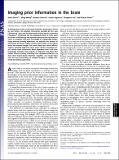| dc.contributor.author | Gorlin, Scott | |
| dc.contributor.author | Meng, Ming | |
| dc.contributor.author | Sharma, Jitendra | |
| dc.contributor.author | Sugihara, Hiroki | |
| dc.contributor.author | Sur, Mriganka | |
| dc.contributor.author | Sinha, Pawan | |
| dc.date.accessioned | 2016-05-18T15:59:11Z | |
| dc.date.available | 2016-05-18T15:59:11Z | |
| dc.date.issued | 2012-05 | |
| dc.date.submitted | 2011-07 | |
| dc.identifier.issn | 0027-8424 | |
| dc.identifier.issn | 1091-6490 | |
| dc.identifier.uri | http://hdl.handle.net/1721.1/102527 | |
| dc.description.abstract | In making sense of the visual world, the brain's processing is driven by two factors: the physical information provided by the eyes (“bottom-up” data) and the expectancies driven by past experience (“top-down” influences). We use degraded stimuli to tease apart the effects of bottom-up and top-down processes because they are easier to recognize with prior knowledge of undegraded images. Using machine learning algorithms, we quantify the amount of information that brain regions contain about stimuli as the subject learns the coherent images. Our results show that several distinct regions, including high-level visual areas and the retinotopic cortex, contain more information about degraded stimuli with prior knowledge. Critically, these regions are separate from those that exhibit classical priming, indicating that top-down influences are more than feature-based attention. Together, our results show how the neural processing of complex imagery is rapidly influenced by fleeting experiences. | en_US |
| dc.description.sponsorship | Merck Foundation | en_US |
| dc.description.sponsorship | James S. McDonnell Foundation | en_US |
| dc.description.sponsorship | Simons Foundation | en_US |
| dc.description.sponsorship | National Institutes of Health (U.S.) (Grant EY07023) | en_US |
| dc.description.sponsorship | National Eye Institute (Grant R21EY015521-01) | en_US |
| dc.language.iso | en_US | |
| dc.publisher | National Academy of Sciences (U.S.) | en_US |
| dc.relation.isversionof | http://dx.doi.org/10.1073/pnas.1111224109 | en_US |
| dc.rights | Article is made available in accordance with the publisher's policy and may be subject to US copyright law. Please refer to the publisher's site for terms of use. | en_US |
| dc.source | PNAS | en_US |
| dc.title | Imaging prior information in the brain | en_US |
| dc.type | Article | en_US |
| dc.identifier.citation | Gorlin, S., M. Meng, J. Sharma, H. Sugihara, M. Sur, and P. Sinha. “Imaging Prior Information in the Brain.” Proceedings of the National Academy of Sciences 109, no. 20 (May 15, 2012): 7935–40. | en_US |
| dc.contributor.department | Massachusetts Institute of Technology. Department of Brain and Cognitive Sciences | en_US |
| dc.contributor.department | Picower Institute for Learning and Memory | en_US |
| dc.contributor.mitauthor | Gorlin, Scott | en_US |
| dc.contributor.mitauthor | Sharma, Jitendra | en_US |
| dc.contributor.mitauthor | Sugihara, Hiroki | en_US |
| dc.contributor.mitauthor | Sur, Mriganka | en_US |
| dc.contributor.mitauthor | Sinha, Pawan | en_US |
| dc.relation.journal | Proceedings of the National Academy of Sciences | en_US |
| dc.eprint.version | Final published version | en_US |
| dc.type.uri | http://purl.org/eprint/type/JournalArticle | en_US |
| eprint.status | http://purl.org/eprint/status/PeerReviewed | en_US |
| dspace.orderedauthors | Gorlin, S.; Meng, M.; Sharma, J.; Sugihara, H.; Sur, M.; Sinha, P. | en_US |
| dspace.embargo.terms | N | en_US |
| dc.identifier.orcid | https://orcid.org/0000-0003-2442-5671 | |
| dc.identifier.orcid | https://orcid.org/0000-0002-8259-7079 | |
| mit.license | PUBLISHER_POLICY | en_US |
